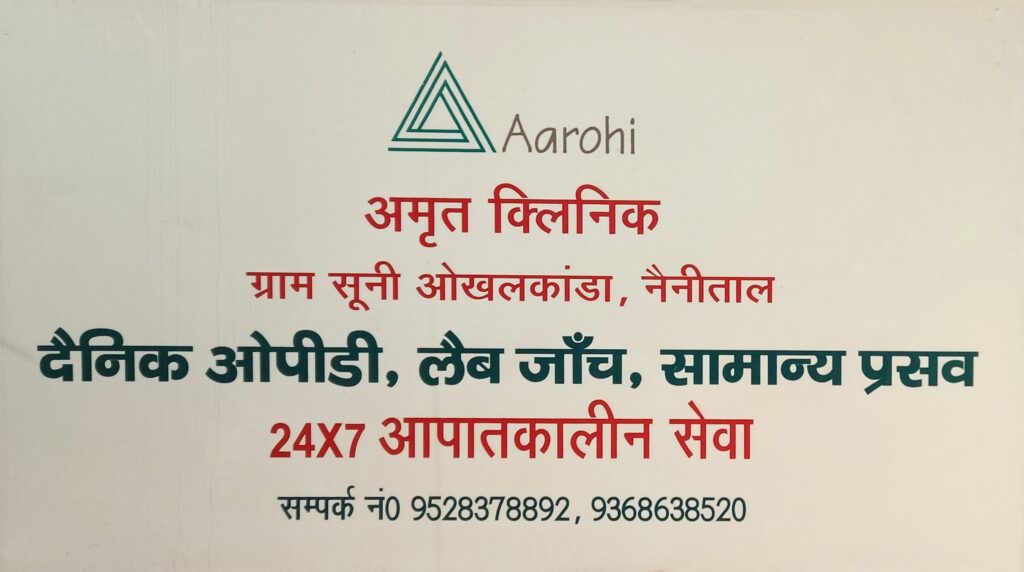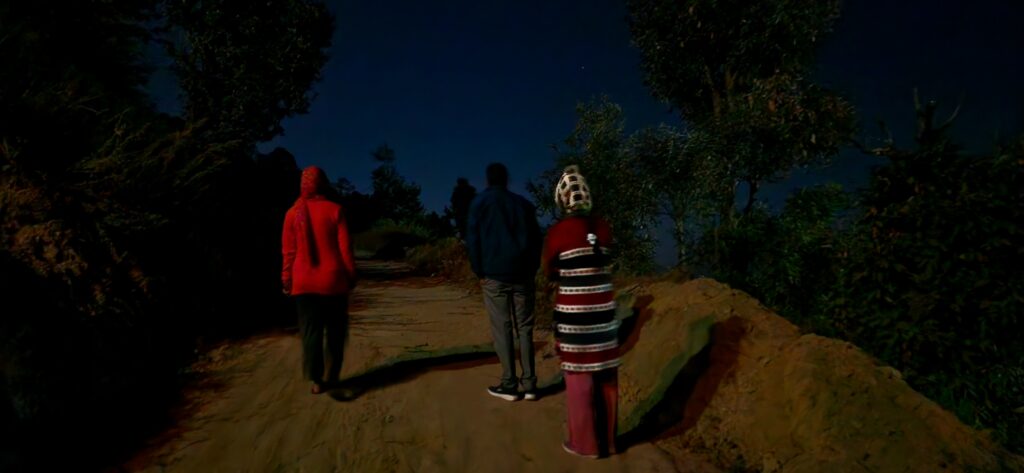I was sitting outside my new residence, mesmerized by the breathtaking view of sparkling lights in the mountains. The government had distributed solar lights to every household in the mountains, transforming the landscape into a beautiful sight after twilight. It felt as though tiny stars from the sky had gently descended onto the earth. I was just about to go inside my room when suddenly one of our community nurses Manju Di, came out of the room in a panic and called out our coordinator and told us,
“Delivery aa rahi hai, hum ambulance mein jati hu unko lene”.
It was my first day on the field. But as fate would have it, at almost 10p.m., in the night we were called in for a woman’s delivery. I didn’t even have a complete tour of our clinic, and I was directly in that space where a woman was about to give birth.
I started working with Aarohi, an NGO in Uttarakhand. Aarohi works to create developmental opportunities for Himalayan communities in Uttarakhand, Nainital district. To understand the Kumaon community’s health-seeking behaviours and Aarohi’s health interventions for providing primary medical facilities in rural parts of the Kumaon region, I was sent to the field, a village called Suni Bend. After an eventful doctor’s day, I was just about to settle in my room when we got to know that one of our ANC patients was in labor, and she was coming to our clinic for delivery.

The Dreadful Journey
I took my stuff and went to our coordinator’s back door. Being surrounded by that darkness immediately reminded me that I was listening to a lot of stories of wild animals; I had even witnessed a patient who got into an accident because of a leopard. In the dark silence of the night, I heard something. I am not sure what it was. I started pounding that door, and I immediately ran towards the front door.
Luckily I saw Chitra ma’am coming from the front door; I felt relieved seeing her. On that obscure night, I, along with Chitra ma’am and Mewadi ji (Dadda), hurried down to the clinic. The clinic was only 500 meters away, but the road ahead was unfamiliar to me. It filled me with unease. There were no street lights to guide us. The constant sound of rustling leaves and the hums of insects made the silence of the night even heavier. I couldn’t help but think about the possibility of encountering a wild animal or a snake.

The journey through the dark and the desolate road felt endless, but with every passing moment, the urgency of the situation kept us moving. We quickly and safely made it to our clinic named Amrit Clinic. Our arrival shifted the atmosphere of the room. Chitra ma’am immediately took charge. The deep silence of the night sharply contrasted with the chaos inside the ward. Everything was set now, and we were just waiting for the pregnant woman to reach the clinic.
Relentless Journey Of The Labor
A harsh sound of breaks from the ambulance alerted everyone of the patient’s arrival. Someone opened the ward door, and a lady was randomly walking with only a little discomfort. I could only identify her as pregnant because of the small bump on her lower belly. She was guided to bed by her Devrani (younger sister-in-law), a health worker from Aarohi, and the ASHA worker from her village. Despite her condition, she seemed calm, showing only mild discomfort. She rested for a while until her contractions and the intensity of the pain started increasing. She was then advised to keep moving around.
I heard a discussion saying, “Ye to acche se cooperate kar rahi hai,” and the reply came, “Haan, iska to multigravida hai na.”. The woman was giving birth for the 7th time; she already had given birth to 6 girls, of which one girl child she gave away to her relatives to take care of. The woman was hoping for a boy this time. This desire wasn’t something very unusual, but the intensity was something I was witnessing for the first time. It was very obvious that, if she didn’t get what she wanted, this wouldn’t be the end. So everyone was praying to God to fulfil her wish.

In The Shadow Of Birth
Finally, the time came; her water broke, and they took her inside the labor room. The labor room was already crowded and I didn’t have that much courage to witness the childbirth, as it was already overwhelming. So, I stayed outside the labor room. It had already started raining outside, and the moment they took her inside, the electricity went off. Luckily, there was power backup in the labor room. The heavy sounds of the woman screaming were echoing in the room. Chitra ma’am had said when the rains had started,
“Ye ekdum Gokulashtami jaisa hua hai, nahi?”
But yes, darkness, thunderstorms, and the nighttime had converted the delivery into a little dramatic scenario. Suddenly the screaming stopped, and I heard a burst of cheerful laughter from the labor room. In the darkness of the moment, the words fell upon my ears: “Ladka hua hai, badhai ho!”. It was a boy. Her sister-in-law came out of the labor room; her eyes were filled with tears of happiness, and she immediately called home and informed.
I went inside, but the moment froze when I saw the baby. He had an umbilical cord tied around his neck at the time of delivery, because of which lack of oxygen supply to his head turned it completely blue. It was very cold outside, so we put him in the baby warmer. When I turned to his mother, she was still filled with a lot of pain and discomfort. I witnessed a few post-delivery procedures, like the removal of the placenta and looking for signs of postpartum complications that can occur.
The Weight Of Choices
After completing all the documentation, we returned to our rooms. The night felt darker and quieter than before. The fear I felt earlier was now replaced by the heaviness of what I had just seen. The next morning, during one of the interactions, the woman revealed that this was not her 7th but her 9th baby. Yet she only had six daughters. The fate of the other two was sadly no mystery.
Continuing to have children until a son is born, often at the cost of neglecting or losing daughters, is a shadowed reality of motherhood in India. This cycle places an immense burden on women, not only physically but also emotionally and psychologically.
After hearing her story, I felt an overwhelming sense of helplessness. Questions swirled in my mind, refusing to settle: What is it that makes them crave so much for a boy, driving them to endure such pain? Why does such hatred for the girl child exist? How are these deeply embedded social norms formed? This systematic gender bias—how can we ever undo it?




0 Comments